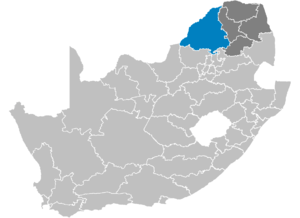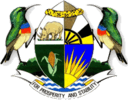Waterberg District Municipality
| Waterberg | ||
|---|---|---|
| District Municipality | ||
| ||
.svg.png) Location in Limpopo | ||
| Coordinates: 24°42′S 28°24′E / 24.700°S 28.400°ECoordinates: 24°42′S 28°24′E / 24.700°S 28.400°E | ||
| Country | South Africa | |
| Province | Limpopo | |
| Seat | Modimolle | |
| Local municipalities | ||
| Government[1] | ||
| • Type | Municipal council | |
| • Mayor | Rosina Mokgotlane | |
| Area | ||
| • Total | 44,913 km2 (17,341 sq mi) | |
| Population (2011)[2] | ||
| • Total | 679,336 | |
| • Density | 15/km2 (39/sq mi) | |
| Racial makeup (2011)[2] | ||
| • Black African | 91.2% | |
| • Coloured | 0.5% | |
| • Indian/Asian | 0.4% | |
| • White | 7.6% | |
| First languages (2011)[3] | ||
| • Northern Sotho | 56.4% | |
| • Tswana | 11.5% | |
| • Tsonga | 8.3% | |
| • Afrikaans | 7.7% | |
| • Other | 16.1% | |
| Time zone | SAST (UTC+2) | |
| Municipal code | DC36 | |

Waterberg is one of the 5 districts of Limpopo province of South Africa. The seat of Waterberg is Modimolle. The majority of its 614 139 people speak Northern Sotho (2001 Census). The district code is DC36.
Geography
The municipality contains much of the Waterberg Biosphere, a UNESCO designated Biosphere Reserve. The Waterberg Biosphere is a massif of approximately 15,000 square kilometers. Waterberg is the first region in the northern part of South Africa to be named as a Biosphere Reserve by UNESCO. The extensive rock formation was shaped by hundreds of millions of years of riverine erosion to yield diverse bluff and butte landform.[4] The ecosystem can be characterised as a dry deciduous forest or Bushveld. Within the Waterberg there are archaeological finds dating to the Stone Age, and nearby are early evolutionary finds related to the origin of humans.
The following sets forth neighboring municipalities and principal municalities within the Waterberg District Municipality:
Neighbours
Waterberg is surrounded (clockwise) by:
- Vhembe (DC34) to the north-east
- Capricorn (DC35) to the east
- Sekhukhune (CBDC3) to the south-east
- Nkangala (DC31) to the south-east
- Metsweding (CBDC2) to the south
- Bojanala Platinum (DC37) to the south
- Ngaka Modiri Molema (DC38) to the south-west
- the republic of Botswana to the west
Local municipalities
The district contains the following local municipalities:
| Local municipality | Population | % | Dominant language |
|---|---|---|---|
| Mogalakwena | 298 433 | 48.59% | Northern Sotho |
| Lephalale | 96 096 | 15.65% | Northern Sotho |
| Modimolle | 72 802 | 11.85% | Northern Sotho |
| Thabazimbi | 63 912 | 10.41% | Tswana |
| Bela-Bela | 52 128 | 8.49% | Northern Sotho |
| Mookgopong | 30 753 | 5.01% | Northern Sotho |
Demographics
The following statistics are from the 2001 census.
| Language | Population | % |
|---|---|---|
| Northern Sotho | 357 100 | 58.15% |
| Tswana | 75 741 | 12.33% |
| Tsonga | 57 511 | 9.36% |
| Afrikaans | 52 379 | 8.53% |
| Ndebele | 29 724 | 4.84% |
| Sotho | 11 752 | 1.91% |
| Xhosa | 10 074 | 1.64% |
| English | 5 843 | 0.95% |
| Other | 4 801 | 0.78% |
| Venda | 4 446 | 0.72% |
| Zulu | 2 968 | 0.48% |
| Swati | 1 785 | 0.29% |
Gender
| Gender | Population | % |
|---|---|---|
| Female | 319 202 | 51.98% |
| Male | 294 937 | 48.02% |
Ethnic group
| Ethnic group | Population | % |
|---|---|---|
| Black African | 557 896 | 90.84% |
| White | 53 150 | 8.65% |
| Coloured | 1 683 | 0.27% |
| Indian/Asian | 1 410 | 0.23% |
Age
| Age | Population | % |
|---|---|---|
| 000 - 004 | 66 353 | 10.80% |
| 005 - 009 | 73 363 | 11.95% |
| 010 - 014 | 74 634 | 12.15% |
| 015 - 019 | 71 809 | 11.69% |
| 020 - 024 | 54 886 | 8.94% |
| 025 - 029 | 50 047 | 8.15% |
| 030 - 034 | 41 052 | 6.68% |
| 035 - 039 | 38 574 | 6.28% |
| 040 - 044 | 32 041 | 5.22% |
| 045 - 049 | 26 397 | 4.30% |
| 050 - 054 | 20 278 | 3.30% |
| 055 - 059 | 14 944 | 2.43% |
| 060 - 064 | 15 509 | 2.53% |
| 065 - 069 | 11 318 | 1.84% |
| 070 - 074 | 10 039 | 1.63% |
| 075 - 079 | 5 460 | 0.89% |
| 080 - 084 | 4 550 | 0.74% |
| 085 - 089 | 1 727 | 0.28% |
| 090 - 094 | 725 | 0.12% |
| 095 - 099 | 322 | 0.05% |
| 100 plus | 111 | 0.02% |
Politics
Election results
Election results for Waterberg in the South African general election, 2004.
- Population 18 and over: 355 225 [57.84% of total population]
- Total votes: 196 790 [32.04% of total population]
- Voting % estimate: 55.40% votes as a % of population 18 and over
| Party | Votes | % |
|---|---|---|
| African National Congress | 166 373 | 84.54% |
| Democratic Alliance | 14 654 | 7.45% |
| Freedom Front Plus | 3 965 | 2.01% |
| United Democratic Movement | 3 405 | 1.73% |
| African Christian Democratic Party | 1 932 | 0.98% |
| Pan African Congress | 1 679 | 0.85% |
| New National Party | 952 | 0.48% |
| Azanian People's Organisation | 928 | 0.47% |
| United Christian Democratic Party | 573 | 0.29% |
| Independent Democrats | 567 | 0.29% |
| Inkhata Freedom Party | 460 | 0.23% |
| NA | 407 | 0.21% |
| SOPA | 165 | 0.08% |
| EMSA | 140 | 0.07% |
| CDP | 127 | 0.06% |
| PJC | 121 | 0.06% |
| UF | 111 | 0.06% |
| TOP | 95 | 0.05% |
| NLP | 55 | 0.03% |
| Minority Front | 43 | 0.02% |
| KISS | 38 | 0.02% |
| Total | 196 790 | 100.00% |
See also
References
- ↑ "Contact list: Executive Mayors". Government Communication & Information System. Retrieved 22 February 2012.
- 1 2 "Statistics by place". Statistics South Africa. Retrieved 27 September 2015.
- ↑ "Statistics by place". Statistics South Africa. Retrieved 27 September 2015.
- ↑ C.Michael Hogan, Mark L. Cooke and Helen Murray, The Waterberg Biosphere, Lumina Technologies, May 22, 2006.

.svg.png)